The Vacation Report - Europe 1998
All pictures are linked - click on them to get a larger image with captions.
We arrived in Paris around noon on Wednesday, May 27th, having been
up for 24 hours, picked up a rented car, and drove to a motel, where we
slept for several hours. I was sufficiently tired before sleeping that
I could not find the reverse gear on the manual gearshift of the rental
car, which fortunately we managed without. Then we got up, had dinner,
and went back to bed. It took me about 15 seconds after some sleep to figure
out the gearshift.
The next day, we drove down to Versailles, and camped after visiting
the "chateau" there. For the purposes of this narrative, chateau is equivalent
to "palace". Versailles is awesome in terms of its size, but Fontainbleu
turned out to have a much better preserved interior.
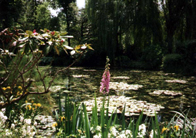 On
Friday, we visited Monet's home in Giverny, which is now a museum, as well
as a town market day in the town next to Giverny. Monet's home is gorgeous.
If you know his work, his water-garden pictures were inspired by his own
gardens, now preserved as part of the museum.
On
Friday, we visited Monet's home in Giverny, which is now a museum, as well
as a town market day in the town next to Giverny. Monet's home is gorgeous.
If you know his work, his water-garden pictures were inspired by his own
gardens, now preserved as part of the museum.
Saturday, we took the train from Versailles into Paris. Driving in Paris
isn't smart - the traffic is terrible, and it's hard to find a parking
place. The trains are cheap and run frequently. The Eiffel Tower was too
crowded, so we put if off for the end of the trip, and went several other
places, including the Louvre, the national art museum, where we spend a
good part of the afternoon. Paris is obviously way too big for one day,
and we planned another at the end of the trip.
Sunday, May 31, we drove to Blere, in the Loire Valley, and camped for
two days on the bank of the river Cher while we explored local chateaus.
On this trip, we tried to limit long driving days - the point was to relax
and see the sights, not to try to see all of Western Europe in a month.
Afternoon naps were features of many days.
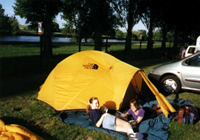 A
word about camping in Europe. France, about the size of Texas, has 10,000
plus campgrounds. Nearly every village has a municipal campground, with
toilets, showers, and places for washing clothes and dishwashing. They
are better set-up for tent camping than most U.S. campgrounds are, where
the assumption seems to be that everyone owns a motorhome, and are easy
to find, with signs in the village center pointing the way to the campground.
Britain, Switzerland, and Italy are much the same. Britain is dominated
by private clubs, but ten pounds bought us a temporary "overseas visitor"
membership that gave us access to over 6,000 private sites in the U.K.
The cost averaged about $25 U.S. per night for 4 people.
A
word about camping in Europe. France, about the size of Texas, has 10,000
plus campgrounds. Nearly every village has a municipal campground, with
toilets, showers, and places for washing clothes and dishwashing. They
are better set-up for tent camping than most U.S. campgrounds are, where
the assumption seems to be that everyone owns a motorhome, and are easy
to find, with signs in the village center pointing the way to the campground.
Britain, Switzerland, and Italy are much the same. Britain is dominated
by private clubs, but ten pounds bought us a temporary "overseas visitor"
membership that gave us access to over 6,000 private sites in the U.K.
The cost averaged about $25 U.S. per night for 4 people.
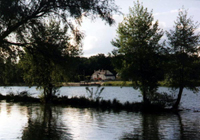 We
only stayed in hotels two days aside from the entry and exit nights, in
Switzerland due to persistent rain. We took two small tents, mattress pads,
and sleeping bags. We took a small Gaz stove, for which propane is readily
available in most French grocery stores and many campground offices, which
we mostly used for making coffee in the morning. We bought some canned
goods to carry in the car in case we got caught coming in after the markets
were closed, but never used them. Camping in Europe is, for us, the way
to go. If we'd have had to stay in hotels, we couldn't have afforded to
go.
We
only stayed in hotels two days aside from the entry and exit nights, in
Switzerland due to persistent rain. We took two small tents, mattress pads,
and sleeping bags. We took a small Gaz stove, for which propane is readily
available in most French grocery stores and many campground offices, which
we mostly used for making coffee in the morning. We bought some canned
goods to carry in the car in case we got caught coming in after the markets
were closed, but never used them. Camping in Europe is, for us, the way
to go. If we'd have had to stay in hotels, we couldn't have afforded to
go.
On Monday, June 2nd, we drove up to Bayeaux in Normandy,
and visited the Bayeaux Tapestry, which dates back to the days of William
the Conqueror, and is a 170-meter tapestry showing the conquest of Britain
by William, concentrating on the Battle of Hastings in 1066. The tapestry
is fascinating, and the narrative which accompanies the tapestry indicates
that the British and French still disagree over the role of William - they
still hold grudges nearly a millennium after the event.
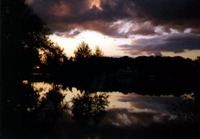
The next day, we drove to the Normandy Beaches. I walked Lisa's girls
through the U.S. cemetery at Omaha Beach. I think the sight of all those
crosses on the graves, which go on as far as the eye can see, made the
point that freedom has a price.
Then we drove up to Calais, and crossed the English Channel to Dover
on a high-speed catamaran ferry, making the crossing in a bit less than
an hour. We camped overnight at Canterbury, and the next morning visited
the Canterbury cathedral, where Thomas Beckett was murdered on the order
of Henry the Second for pointedly ignoring Henry's orders on church policy.
In the afternoon, we drove to Chertsey, a little town on the Thames,
where we camped the next two nights while exploring the London area. We
took the train into London, as in Paris. We took a bus tour of London,
which will let you off to see various sights and then get back on. We saw
Buckingham Palace and a host of other places. We spent part of the afternoon
touring the Tower of London, which really isn't a tower but a fortress.
The crown jewels are splendid, and the site is well-preserved. One of the
officers who guard the tower, asked where the bathrooms were, roared, "You
can't take a BATH here, mate - but the toilets are in that direction!"
One for him.
The next day, on the way out of town, we visited Hampton Court Palace,
which is a great place. They have kitchens and other rooms preserved or
restored to medieval condition, so one can see how food was prepared and
served, and the palace guardroom is extremely impressive, with the walls
covered with weapons.
We ate both nights at Chertsey at a little pub on the Thames next to
the campground. The food was very good, and reasonably-priced, unlike many
restaurants we ate at in France. I think British cooking has gotten a bum
rap. They may not produce haute cuisine - but they have good food.
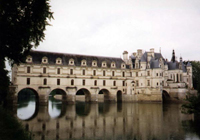 On
Saturday, June 6th, we visited Stonehenge, which is a lot older
than I realized, dating back nearly 5,000 years. The girls were quite impressed.
Then we camped for the next two nights in Salisbury, where there is another
big cathedral. The cathedral was closed because of a big festival on the
grounds - we could hear a concert from the camp, and saw fireworks. The
next day we visited the town of Bath, which is wonderfully preserved and
has an ancient bathhouse dating back to Roman times.
On
Saturday, June 6th, we visited Stonehenge, which is a lot older
than I realized, dating back nearly 5,000 years. The girls were quite impressed.
Then we camped for the next two nights in Salisbury, where there is another
big cathedral. The cathedral was closed because of a big festival on the
grounds - we could hear a concert from the camp, and saw fireworks. The
next day we visited the town of Bath, which is wonderfully preserved and
has an ancient bathhouse dating back to Roman times.
Monday, we drove to Dover, and spent the afternoon exploring the fortress
there, which dates back to ancient times, but also has an underground tunnel
complex which was used in WWII - it was the nerve center for the Dunkirk
evacuation. They give a great tour of the complex, with extensive narration.
We camped near there in Deal, accompanied by obvious puns about the name
- "What a deal!" - and woke up to a driving rain. We packed the
tents into the car wet, and got an early start across the channel back
to the continent.
Europe is small for people used to driving across West Texas. After
crossing the channel, we drove across Belgium and Luxembourg into Baccarat,
France, where we camped. Baccarat is the home of the crystal factory, and
there is a museum there which opened late, so we'll see it another trip.
It was clear when we camped, but raining - again - when we got up. A short
hop the next day got us into Interlaken, Switzerland around noon, still
in the rain. That's when we checked into a nice family-run hotel for a
couple of days.
The next day, we visited the Swiss Open-Air Museum at Hofstedt, at the
other end of the lake from Interlaken. They have well-preserved Swiss houses
there, and people performing actual crafts, like cheese-making, blacksmithing,
and pottery. We also did some sightseeing and shopping in Interlaken.
The forecast was for continued rain, so on Friday, we ran over Gotthard
Pass into Italy. The sun was out on the Italian side of the pass, so we
stopped for a picnic lunch and to dry out the camping gear. We stopped
for the evening at Canarro on the shores of Lake Maggiore, and had a delightful
dinner at a restaurant on the bank of the lake. After two days of cold
rain in Switzerland, the warm, dry weather in Italy was wonderful.
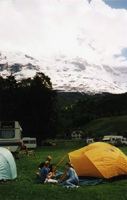 The
weather over Switzerland appeared to have cleared out, so we drove over
Simplon Pass, which had a lot of snow at the top, back to Switzerland,
and into Grindelwald. The next day, we took a cog train from Grindelwald
up to the Jungfraujoch, which they call the "Top of Europe". It's 11,360
feet up on the Jungfrau. The view was incredible. The train stops on the
way up at the Eigerwand, a window in the north face of the Eiger, a mountain
which was not successfully summited until 1938 and has killed a number
of climbers. The tents I have are made by a company called The North Face,
after that side of the Eiger. We stopped on the way down at a town called
Kleinescheiddeg for lunch. It's the starting point for many Swiss alpine
hikes.
The
weather over Switzerland appeared to have cleared out, so we drove over
Simplon Pass, which had a lot of snow at the top, back to Switzerland,
and into Grindelwald. The next day, we took a cog train from Grindelwald
up to the Jungfraujoch, which they call the "Top of Europe". It's 11,360
feet up on the Jungfrau. The view was incredible. The train stops on the
way up at the Eigerwand, a window in the north face of the Eiger, a mountain
which was not successfully summited until 1938 and has killed a number
of climbers. The tents I have are made by a company called The North Face,
after that side of the Eiger. We stopped on the way down at a town called
Kleinescheiddeg for lunch. It's the starting point for many Swiss alpine
hikes.
On Monday, we returned to Italy, driving past Gstadd, a famous ski resort
for the rich and shameless, and on a high-speed Italian motorway all the
way to the Mediterranean, to a town called Ambisola. The campground there
was wonderful. The camping sites were terraced over the Med, so the view
was stunning from 70 feet up on the side of the shoreline. The campground,
with its wonderful view, was costing us a grand total of $12 U.S. per night,
and wine was cheaper than Coca-Cola. Many Italian restaurants are closed
on Monday, but we found a pizza place open, and the owner spoke excellent
English. The place was very busy, and we never found out where he learned
his English.
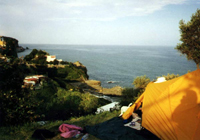
The next day, we relaxed and went to the beach. Beach space is rare
and expensive in Italy - the sand is imported, as the natural coastline
is rocks - and most of the town beach was composed of private beach clubs,
where people pay an annual fee to reserve a beach chair and the right to
use the beach. We paid a low fee as visitors to the club, which was not
being heavily used on a weekday, though traffic picked up during the lunch-time
siesta from 1:30 to 4:00 P.M. when all the shops are closed. We watched
some locals playing a game I have never seen before, a cross between soccer
and volleyball, played on a small volleyball court with two persons per
side. The ball is served by kicking it over the net, and can be returned
using head, chest, feet - anything but hands. It's interesting to watch,
but playable, I expect, only by people who have grown up playing soccer.
The people we watched were quite good.
One Wednesday the 17th, we drove over to Villaneuve Loubet,
France, just west of Nice. There is a lovely campground there, within walking
distance of the beach. We stayed there four nights. The campground had
wonderful facilities, with immaculate restrooms, and a snackbar/bar/gameroom.
The children hit it every afternoon for ice cream. A big grocery store
was a block away, so we didn't have to drive anywhere.
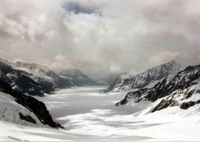 The
beach is not sand, being made of gravel. This turned out to be a treat,
as the rocks are highly polished by the waves, are quite comfortable to
sit on, and don't stick to your body like the sand on salt-water beaches
does. The French universities had just let out, and the beaches were populated
by college girls wearing only the bottoms of their bikinis. Naturally,
I found this practice shocking! Thank goodness for sun block with a 36
SPF, or I'd have been badly burned. The water was very nice, though a bit
cool, and seemed to be less saline than most salt water I've been in. The
beaches had fresh-water showers every 50 meters to wash the salt-water
off with, which is very nice.
The
beach is not sand, being made of gravel. This turned out to be a treat,
as the rocks are highly polished by the waves, are quite comfortable to
sit on, and don't stick to your body like the sand on salt-water beaches
does. The French universities had just let out, and the beaches were populated
by college girls wearing only the bottoms of their bikinis. Naturally,
I found this practice shocking! Thank goodness for sun block with a 36
SPF, or I'd have been badly burned. The water was very nice, though a bit
cool, and seemed to be less saline than most salt water I've been in. The
beaches had fresh-water showers every 50 meters to wash the salt-water
off with, which is very nice.
While we were there, we visited the town of Grasse, which is the traditional
home of the French perfume industry. The museum there has wonderful detail
about the industry, showing how perfume is made, and even has a greenhouse
with the plants used, where one can scent the various ingredients which
go into making perfume. The village is on a hilltop, and we parked in a
parking garage which had fifteen floors. We drove in on the top floor,
near the level of the main town square, and out the bottom. Like many villages,
it had a big pedestrian square where the girls bought gifts for their friends.
Finally, it was time to head back toward Paris for the trip home. We
hopped on the autoroutes, and did the 940 kilometres back to Paris in one
day. The autoroutes are wonderful. They are toll roads, and you get a ticket
when you get on, and pay when you get off. The Renault Megane we rented
hummed along all day at 140 kilometers per hour, about 85 MPH, getting
26.5 miles per gallon with four of us aboard.
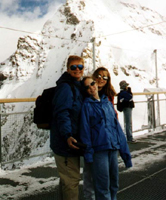
A word about the roads and driving. The roads in Europe are uniformly
as good as those in the U.S., and better marked. Signs are easy to understand,
most being in international symbology, the rest being easy to figure out.
European drivers, in my experience, are better than those of the U.S. The
autoroutes and motorways, which correspond to our Interstate highways,
are better maintained, and traffic on them moves in a hurry. I never saw
a radar trap. There is absolutely strict observance of the rule of slower
traffic keeping to the right. Everyone drives in the right lane except
when passing slower traffic, and everyone signals before changing lanes.
Tarry in the left lane, and you're liable to have someone in a BMW moving
at 200 kilometers per hour running up behind you.
There are not many big cars in Europe, where gasoline is four times
as expensive as in the U.S. The emphasis is on small, maneuverable cars,
as the secondary roads are often quite narrow.
There is a minimum of traffic lights in Europe, away from the big cities.
Intersections are marked by roundabouts, which have a central circle. You
enter the roundabout, yielding to traffic already in the circle, and go
around the circle until you get to your exit. One sign well prior to the
roundabout indicates where all the exit roads lead, so navigation is easy,
and there are more signs on each exit road. Once one gets used to these,
they make vastly more sense than stoplights and stop signs, as traffic
moves through much faster on average, rarely requiring a full stop. When
we got back to Houston, and started hitting lights, I said to Lisa, "What's
with all these traffic lights? Haven't these people heard about roundabouts?",
to which she replied, "These Americans - they just aren't civilized!"
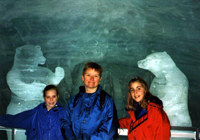 One
things which does require a bit of an adjustment is roundabouts in England,
where they drive on the left-hand side of the road, and you enter a roundabout
turning to the left. A couple of hours of practice, though, and one learns.
I did pull out in the mornings in England reminding myself to drive on
the left, but one quickly gets used to that.
One
things which does require a bit of an adjustment is roundabouts in England,
where they drive on the left-hand side of the road, and you enter a roundabout
turning to the left. A couple of hours of practice, though, and one learns.
I did pull out in the mornings in England reminding myself to drive on
the left, but one quickly gets used to that.
Back up north, we camped on the left bank of the Seine in a town called
Melun, to visit the chateau at Fountainbleu. Said to be Napolean's favorite,
it is certainly the best preserved of those we visited. A lot of chateaus
had their furniture destroyed during the French revolution, but Fountainbleu
did not, and has the most impressive interiors. The occupants certainly
did live like kings.
Finally, the day before returning to the U.S., we got up early and drove
to the airport. We checked into an airport hotel, and hopped the train
into Paris. The girls and I went to the top of the Eiffel tower, with its
splendid view, and then we spent the afternoon shopping on the Champs Elysees,
arguably the most exclusive shopping district outside of Rodeo Drive. Not
much got purchased, but the girls enjoyed seeing the stores, and I enjoyed
people-watching.
And, finally, a word about people and language. I spent the six weeks
prior to the trip taking the first part of the U.S. Foreign Service Institute
Basic French Course, which comes with a book and 13 compact disks. It was
well worth the effort, because even outside of France, a lot of people
have some familiarity with French. A lot of French people who profess not
to speak English if asked in English, turn out to understand a lot of English
if one tries to communicate with them in French first. And it doesn't take
much French, or any language, to get by in restaurants and grocery stores.
We didn't have much trouble getting around, though good maps are essential,
as my French was not enough to understand a complicated set of directions.
The problems we encountered were cultural, like knowing that grocery stores
are closed on Sunday afternoons and many shops and stores are closed on
Mondays - but we never went hungry.
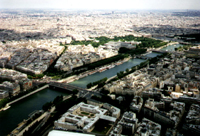 I've
heard that some French people are unfriendly toward American tourists.
We found not a single case of that. Perhaps it's only true toward Americans
who think that all foreigners can understand English if one speaks slowly
enough, but everyone we met was delightfully friendly and helpful. A smile
goes a long way in any language, as does obvious tolerance for customs
different that what one is used to.
I've
heard that some French people are unfriendly toward American tourists.
We found not a single case of that. Perhaps it's only true toward Americans
who think that all foreigners can understand English if one speaks slowly
enough, but everyone we met was delightfully friendly and helpful. A smile
goes a long way in any language, as does obvious tolerance for customs
different that what one is used to.
Costs? Airfare is affordable - we paid less than $600 per person (but
don't try to go in August or late July, when most of Europe is on vacation)
- and a month's car rental cost about $1300 with unlimited mileage and
full insurance. Hotels and restaurants are expensive. We didn't stay in
hotels, except as noted, and ate a maximum of one meal per day in restaurants.
Traveling that way is quite affordable. Europe is definitely an educational
experience, and was especially great for the kids, who had never been out
of the U.S.
We had a great time, and look forward to going back. We didn't have
nearly enough time to see what we wanted to. We are contemplating several
future trips, one to Italy and Greece, one to the Netherlands and Germany/Austria,
and one for England, Scotland and Ireland.
Copyright 1998 by Linden B. Sisk. All rights reserved.
home
Lindy@arcanamavens.com
 On
Friday, we visited Monet's home in Giverny, which is now a museum, as well
as a town market day in the town next to Giverny. Monet's home is gorgeous.
If you know his work, his water-garden pictures were inspired by his own
gardens, now preserved as part of the museum.
On
Friday, we visited Monet's home in Giverny, which is now a museum, as well
as a town market day in the town next to Giverny. Monet's home is gorgeous.
If you know his work, his water-garden pictures were inspired by his own
gardens, now preserved as part of the museum.









